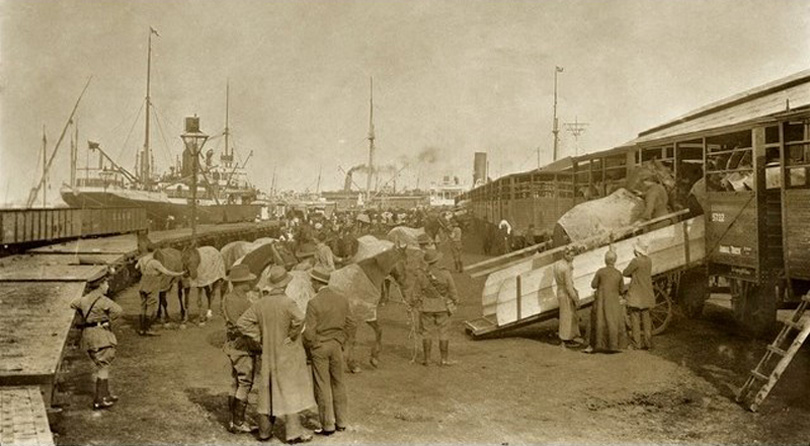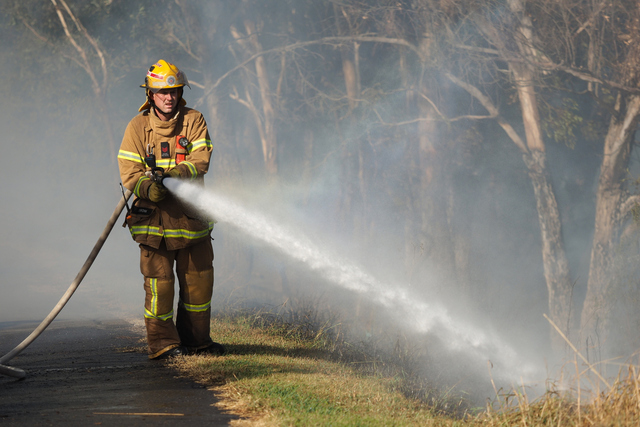In the Bacchus Marsh Express on September 5, 1914, an advertisement appeared urging locals to farewell the first enlistees for the war which had just been declared in Europe. list of men was printed including Charles Edwards, Arthur Hine, Alex Murdoch, Thomas O’Leary, Maurice Whelan, Bill McKenzie and Charles Waterhouse.
At the first of many send-offs, patriotic fervour was high with songs and anthems rendered and many of the district’s dignitaries involved in speeches. Of the 20 men listed attending the meeting many joined either the 7th Battalion or the 4th Light Horse.
The 7th Battalion was commanded by Harold “Pompey” Elliott, who would become one of Australian Military’s most admired leaders. The boys from Bacchus Marsh, including Hine, O’Leary, Waterhouse and Murdoch were joined by men from Footscray and Spotswood to make up C company.
Thomas O’Leary was born in Kyneton but enlisted in Bacchus Marsh, giving his occupation as labourer. Tom’s brother Patrick worked for the Water Commission in Bacchus Marsh. They were cousins of Michael O’Leary, a soldier in the Irish guards who would win the Victoria Cross by capturing a German position, killing eight and capturing two enemy soldiers.
Arthur Hine (enlisting as Alfred William) was a farmer born in Rowsley, and was just 19 years of age. He enlisted in Bacchus Marsh on the August 24, alongside Alex Murdoch, a butcher who had experience in the 8th Battalion cadets and was a member of the Bacchus Marsh Rifle Club.
Charlie Waterhouse was born in England and his occupation was listed as Contractor. He had been in command of the local citizen force prior to enlistment. Charles was one of the earliest to enlist, on the August 15 at Footscray.
After training at Broadmeadows, the 7th Battalion arrived in Egypt on the December 7, 1914.
On the April 25, 1915, the 7th Battalion landed at Gallipoli as part of the second wave of troops ashore.
Within a week, Hine, Murdoch and O’Leary were dead from wounds received at the landing. Waterhouse was shot in the jaw and was evacuated to England where he spent the remainder of the war in hospital. He died in 1922, in England.
Whelan, McKenzie, Edwards and others joined the 4th Light Horse and arrived in Egypt on the December 10, 1914. This was a culture shock for many of the country boys, their amazement at the colour and entertainment surrounding them revealed in letters sent home. Charles Edwards called it “A wonderful place”.
Maurice Whelan and Charles Edwards were both famers born in Bacchus Marsh. Bill McKenzie was a brick maker and a member of both the local football and cricket teams. They all enlisted on the August 19, at Broadmeadows.
Maurice Whelan was at Gallipoli and on the 22nd August 1915 was wounded at Gaba Tepe with a gunshot wound to the left leg. He was returned to Australia on the June 24, 1916 and requested his discharge on the October 4, 1916.
Charles Edwards transferred to the 2nd Light Horse regiment and was promoted to Driver. After serving with the troop in and around Jordan, Charles was sent home on September 15, 1918 on the HMAS Waterhen on “Submarine guard”.
Bill McKenzie was promoted to Lance Corporal and Corporal during his time in the Light Horse and was in the troop at the time of the famous charge of Beersheba on the October 31, 1917. The Australian War Memorial states: On October 31, 1917 an attack was launched to outflank the Turkish bastion of Gaza, against which two previous attacks had failed, by capturing another heavily defended town to the east – Beersheba. A deteriorating tactical situation late on the first day of the operation caused the 4th and its sister regiment, the 12th, to be unleashed on Beersheba at the gallop – an action which has gone down in history as the charge of Beersheba.
Bill McKenzie (below on his wedding day) was granted “1914 Special leave” and was home with his family in time for Christmas 1918.
– Great War Centenary Committee, Bacchus Marsh has provided this third article in a series 2014-18 to mark centenaries of locally significant World War One events. www.bmgwcc.com








